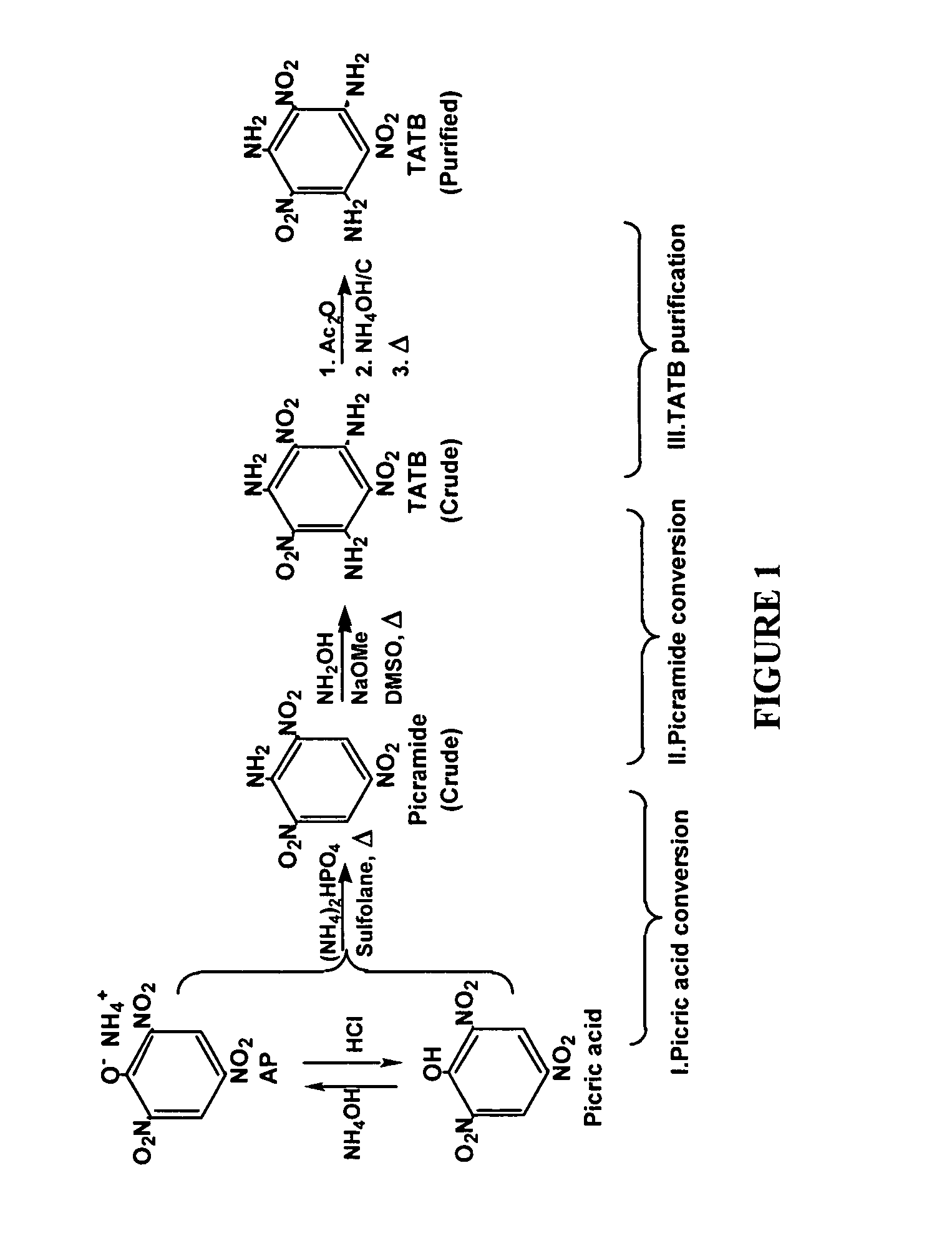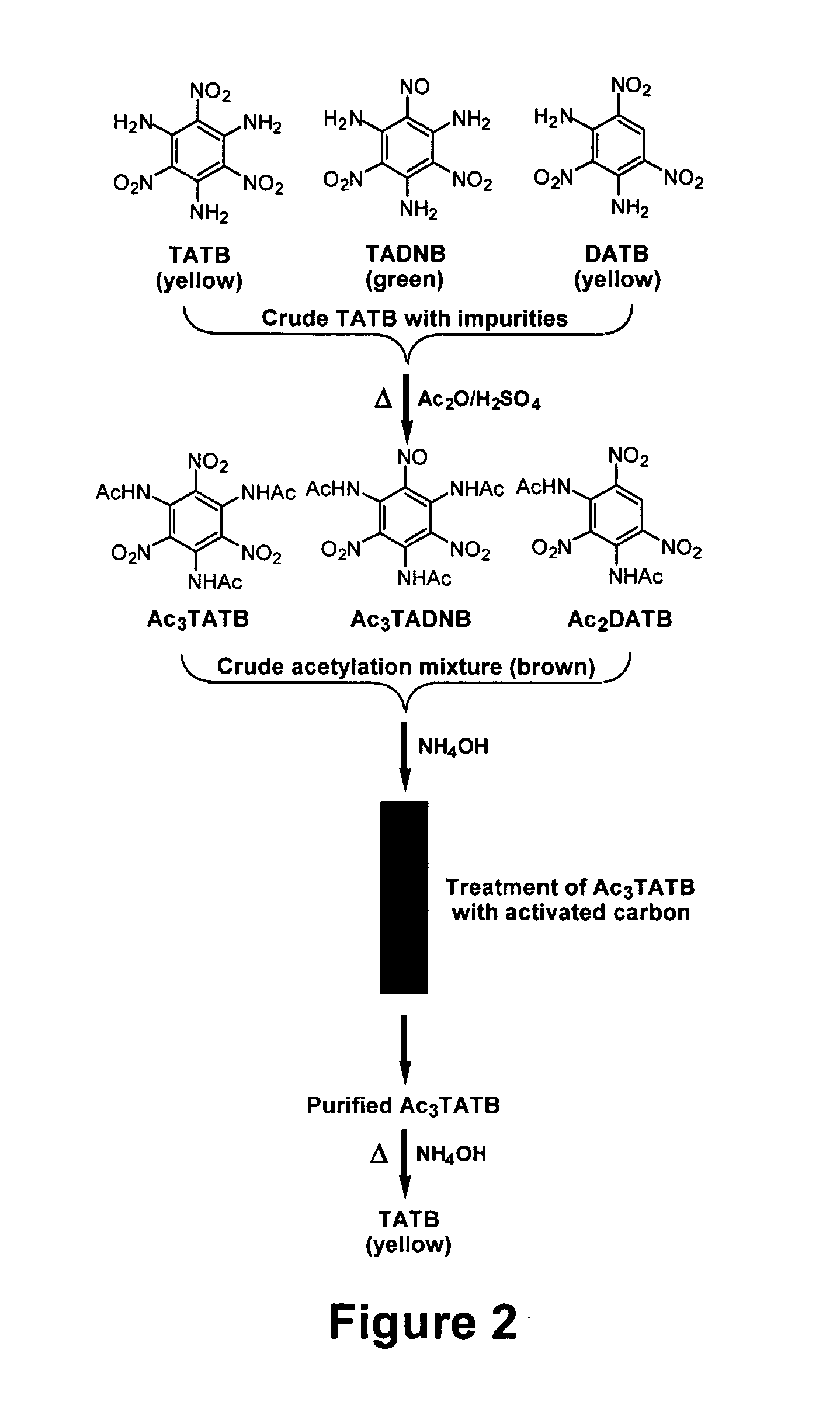Synthesis and purification of 1,3,5-triamino-2,4,6-trinitrobenzene (TATB)
a technology of triamino-2,4,6 and triamino-2, which is applied in the field of synthesis and purification of 1, 3, 5triamino2, 4, 6trinitrobenzene (tatb), can solve the problems of inability to safely and efficiently remove picramide and the inability to dispose of these materials by ob/od
- Summary
- Abstract
- Description
- Claims
- Application Information
AI Technical Summary
Problems solved by technology
Method used
Image
Examples
example 1
[0014] A slurry of picric acid (2.29 g, 0.01 mol ) and urea (1.80 g, 0.03 mol) in sulfolane (2 mL) is heated (167° C.) in a closed pressure vessel for 23 h. 13C-NMR analysis indicates quantitative conversion to picramide and cyanuric acid. Under the same conditions, ammonium picrate (2.46 g, 0.01 mol) and urea (1.80 g, 0.03 mol) in sulfolane (2 mL) gave a complete conversion to picramide and cyanuric acid.
example 2
[0015] (a)Ammonium picrate (0.18 g, 0.75 mmol) and diammonium hydrogen phosphate (0.99 g, 7.5 mmol) are suspended in dry sulfolane (3 ml) and stirred in a Teflon® capped glass pressure tube (8 ml) for 2 hr with the application of heat, which raises the temperature of the reaction from 25° C. to 177° C. The reaction is continued an additional 5 hr at 177° C. and cooled to ambient temperature. Water (30 ml) is added to the slurry and the product is collected and washed with water. Vacuum drying yields 0.13 g (76%) of picramide (Table 1, entry 1).
[0016] (b) Ammonium picrate (0.92 g, 3.7 mmol) and diammonium hydrogen phosphate (0.99 g, 7.5 mmol) are suspended in dry sulfolane (3 ml) and stirred in a Teflon® capped glass pressure tube (8 ml) for 2 hr with the application of heat, which raises the temperature of the reaction from 25° C. to 177° C. The reaction is continued an additional 5 hr at 177° C. and cooled to ambient temperature. Water (30 ml) is added to the slurry and the produc...
example 3
[0022] (a)Ammonium picrate (0.92 g, 3.7 mmol), diammonium hydrogen phosphate (0.99 g, 7.5 mmol) and dry sulfolane (40 ml) are placed in a glass-lined, stainless steel reactor. The reactor is sealed and the reaction slurry is stirred with heating for 2 hr as the temperature increases from 25 to 175° C. (20 psi pressure). The temperature is maintained at 175° C. and stirring is continued for an additional 20 hr. The cooled reaction mixture is mixed with water (400 ml) and the insoluble material is collected, washed with water and dried to give 0.26 g (30%) picramide (Table 2, entry 1).
[0023] (b) Ammonium picrate (0.92 g, 3.7 mmol), ammonium carbamate (7.78 g, 99.6 mmol) and dry N-methylpyrrolidinone (40 ml) are placed in a glass-lined, stainless steel reactor. The reactor is sealed and the reaction slurry is stirred with heating for 2 hr as the temperature increases from 25 to 175° C. (80 psi pressure). The temperature is maintained at 175° C. and stirring is continued for an additio...
PUM
| Property | Measurement | Unit |
|---|---|---|
| Temperature | aaaaa | aaaaa |
| Fraction | aaaaa | aaaaa |
| Time | aaaaa | aaaaa |
Abstract
Description
Claims
Application Information
 Login to View More
Login to View More - R&D
- Intellectual Property
- Life Sciences
- Materials
- Tech Scout
- Unparalleled Data Quality
- Higher Quality Content
- 60% Fewer Hallucinations
Browse by: Latest US Patents, China's latest patents, Technical Efficacy Thesaurus, Application Domain, Technology Topic, Popular Technical Reports.
© 2025 PatSnap. All rights reserved.Legal|Privacy policy|Modern Slavery Act Transparency Statement|Sitemap|About US| Contact US: help@patsnap.com


